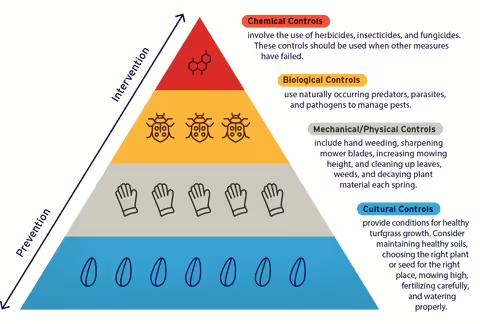URBANA, Ill. – It finally happened; your garden’s first tomato is ready to harvest. Bright red and plump, you can practically taste it, but on closer inspection someone already has. Do you dig out the trusty bottle of insecticide?
Not so fast, says Michelle Wiesbrook, a University of Illinois Extension expert in pesticide safety and horticultural weed science. Pesticides have their place in controlling persistent weed and pest outbreaks, but using them incorrectly can harm pets, kill beneficial insects, and leach chemicals into waterways and drinking supplies.
“We recommend that you use pesticides as a last resort,” Wiesbrook says. “A lot of times there are other controls that will work.”
Integrated Pest Management, IPM, uses a variety of tools to reduce pests and minimize economic, health and environmental risks of chemical interventions.
The first step in managing pests is knowing what you are dealing with. One insect or weed can be mistaken for another and certain products will only affect specific pest species.
“Do your homework first,” Wiesbrook says. “Make sure you know what pest you have before you go to the store and start looking for a product.”
Staff at the University of Illinois Plant Clinic or local county Extension offices can assist with identification, provide recommendations, and also advise on local outbreaks or issues.
Cultural controls are simple preventative steps gardeners can take to cultivate a strong, healthy landscape that is less susceptible to disease and attack.
That’s the approach promoted by Allison Neubauer, an outreach educator with Illinois-Indiana Sea Grant. Neubauer teaches communities about natural lawn care practices so they can cut back on nutrient and chemical pollution, conserve water, and contribute to healthier ecosystems.
Choose the right plant for the right place, water plants consistently, keep gardens and lawns free of materials that might act as a breeding ground for pests, and mow turf to the ideal height of 3 inches.
“We also recommend taking a soil test, especially if it’s a new space, so you know what nutrients there are, and what nutrients are lacking,” Neubauer says. “Then you can customize a treatment plan for a more productive environment.”
Mechanical controls, such as removing pests by hand early, can help prevent outbreaks. Taking a few minutes to pick bagworms out of trees, pour salt on snails, or pull weeds by hand as they pop up goes a long way. Sharpening mower blades is also important. Clean-cut grass blades heal faster and are less likely to look frayed and yellow.
“You might mistake that as a symptom of a nutrient deficiency or a fungal disease when you actually have dull mower blades,” Neubauer says.
Biological controls use nature to fight nature. Gardeners can buy ladybugs and other beneficial predator insects and release them in an area where they will attack pests.
When all else fails, pesticides can be useful tools for persistent problems, but these powerful chemical controls must be used carefully.
Farmers and landscapers are required, by law, to be certified on how to handle restricted-use pesticides. Home gardeners are limited only by what pesticides are available to them in garden centers.
“These are chemicals that are designed to cause harm to living things,” Neubauer says. “It’s not selective and it could still have an impact on non-targeted organisms.”
The first step to safe application is reading the product’s label which will explain what pests it is for and conditions for safe use. For example, not all pesticide formulas can be used on edible plants.
“The label is the law,” Wiesbrook says. “Consumers are actually required to read and follow all label directions.”
The product label will also have directions on how much of the product should be used. If high winds and rain are in the forecast, wait to apply. Some products can injure other desirable plants.
“If the wind is blowing toward your neighbor’s rose bushes, it’s probably a good idea to wait to apply," Wiesbrook says.
More is not better when it comes to pesticides. It is illegal to apply more than what the label directs. The product’s instruction label, called Directions for Use, will note how much to use in what concentration for the square footage of a specific area. For help in determining pesticide rates and calibration, watch a demonstration video at go.illinois.edu/calibration.
The chemicals in pesticides and fertilizers can hurt adults, children, pets, and livestock when inhaled or absorbed through the skin. Safety should be a priority when using them.
“Too many times, I’ve seen people spraying, and their kids or pets are following behind them,” Wiesbrook says. “But people don’t understand the dangers and the risks.”
Safely store chemicals out of reach of children. Always wear personal protective equipment such as coveralls or pants and long-sleeved shirts, gloves, enclosed footwear, a head covering, eyewear, and respirators as required by the product label. Immediately shower and wash clothes worn during application. Read the label to determine how long to stay off turf or garden surfaces.
A more tolerant mindset can be helpful when thinking about pests. Gardening channels and magazines offer up images of flawless landscapes, which sets unrealistic expectations. Weeds are natural and some like dandelions should be tolerated to feed butterflies, bees, and other beneficial insects.
This growing season, instead of reaching for a bottle of pesticide, pick the caterpillars off your tomato plants and let that weed in the back corner of your yard live another day.
SOURCES: Michelle Wiesbrook, University of Illinois Extension Specialist, Pesticide Safety Education Program; Allison Neubauer, Illinois-Indiana Sea Grant, Outreach Associate.
WRITERS: Emily Steele, Communications Coordinator, Illinois Extension
ABOUT EXTENSION: Illinois Extension leads public outreach for the University of Illinois by translating research into action plans that allow Illinois families, businesses, and communities to solve problems, make informed decisions, and adapt to changes and opportunities.
PHOTO ACCESS: The graphic in this article is available to download for media use. Credit: Adapted from Pennsylvania State University. Source: Illinois-Indiana Sea Grant.
